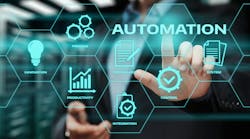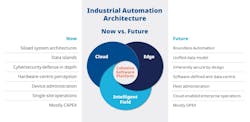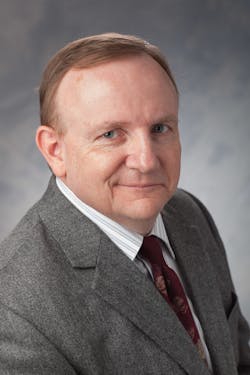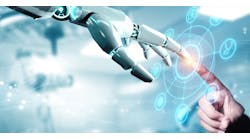It’s been some three decades now since the Purdue model first formalized the seven-layer pyramid for “computer-integrated manufacturing” that those of us in the industrial automation space have all come to know (if not love). And while the model’s intent was primarily functional, form often follows function and the intervening decades have left us with complex strata and siloes of isolated data that is difficult to integrate and contextualize.
Emerson, a longtime leader in the industrial automation space, has a new vision of a flatter, software-based architecture for automation that democratizes data and enables optimization without all the former hurdles. To learn more, we tracked down Emerson technology leader Peter Zornio at the company’s recent Emerson Exchange user conference in Grapevine, Texas, near Dallas. Then chief technology officer for Automation Solutions, Zornio has since been promoted to CTO for the entire Emerson organization.
A: Boundless Automation is our term for the future of operations technology (OT) architecture. That includes everything from intelligent field devices to automation to operational management software—the complete envelope of things that make production operations happen today. We got there pretty simply by looking at the limitations of today's architectures against the technology advances of the IT world in cloud and on what we now call the edge.
The fact that we have very layered, striated architectures with software sometimes tied to very specific hardware, makes it difficult to move data up and down the layers seamlessly. We've built the layers largely as a security construct, or, as you already mentioned, as form follows function. With digital transformation, people went beyond automation into areas like reliability, sustainability and quality, which meant yet mors vertical silos of data with their attendant applications.
We’ve decided that this kind of silos or layers doesn’t make sense going forward. Instead, think of three integrated computing domains—the intelligent field devices, the edge technologies, and the cloud—combined as peers (rather than layers) with a cohesive software environment that ties the applications in those three environments together. That’s really the core concept of Boundless Automation.
Q: You’ve used the phrase “integrated by design” to describe how the various components and systems that participate in these future systems interact with one another. Is this more than the common communication standards and basic information models that we already use?
What we've seen in the software market over the past 20 or 30 years proves that people want and will pay for a unified software ecosystem that provides greater ease of use and provides for usability of the data, what we call data democratization, inside that software ecosystem. Examples close to home include Microsoft’s move to integrated software suites, ecosystems of mobile phones and resident apps, and the original distributed control system (DCS). The DCS has always been an integrated, cohesive suite of automation software that’s been designed from the start to work together. The concept has obvious benefits that we've seen people willing to pay for.
Q: Providing more effective and efficient data management and contextualization has been a key push by Emerson for several years now, and the recent controlling interest acquisition of AspenTech and the inmation technology that it acquired promise to advance those capabilities even further. Can you talk to the importance of effective data management in the Boundless Automation systems of the future, and how the inmation and AspenTech technologies help to advance it?
A: If we've learned anything from customers running digital transformation programs, it's that this concept of data democratization or usable data is what's key. Everybody quickly figured out they could use standards, that they could move data back and forth or put it all together in a data lake in the cloud. What was missing was the context provided by a consistent data model around all that data, to make it usable in actual applications.
And that’s where inmation comes in: it layers a cohesive, S95-based data model over the disparate data models of various applications. But the Boundless Automation vision goes further, in that applications in this integrated software portfolio will leverage a shared data model right from the start. And of course, now, with the combined portfolios of Emerson and Aspen, we have the broadest suite of OT software in industry. It’s a great opportunity to bring them together in the sort of unified software environment that will deliver unparalleled ease of use and data democratization for our customers.
Q: The process automation crowd has long been a pretty conservative bunch—and for good reason—when it comes to adopting new technologies. But the pandemic seems to have only accelerated widespread acceptance of the cloud as an important extension of on-prem automation systems. What advantages does cloud connectivity offer users of Emerson systems, and how does it increase the value you can deliver on their behalf?
A: First off, I’d note that IT has really run to the cloud and embraced it. And frankly, many applications in the OT world are not time critical and could move to the cloud today to take advantage of those same benefit: outsourced infrastructure, no software maintenance, universal access, elastic scalability and pay-as-you-use consumption-based models. The cloud doesn't solve the data integration issues already mentioned but having all the various systems housed together in the cloud is a better starting point.
Q: Just after Exchange, Emerson announced that it had divested a majority stake in the commercial and residential side of its business in a deal that valued the business at $14 billion. Lal Karsenbhai noted that this was “a next step in Emerson’s ambitions to become a global automation player.” That’s a pretty nice nest egg when it comes to investing to increase the footprint and capabilities of what I think of as an already significant force. What can you tell us about what developments we might we expect in the coming months?
A: I think Lal describing it as “a next step” was a little bit of an understatement. Certainly, the deal succeeded in creating the world’s largest pure-play automation company. And frankly, we're big in all areas whether it's sensing, final control, and actual control across process, hybrid and discrete manufacturing. And with Aspen, we’ve set up one of the largest portfolios of OT software. So, you can expect that, yes, we'll take that nest egg and be targeting expansion in all those areas.
It's very clear we're now committed to being a pure-play automation company.





